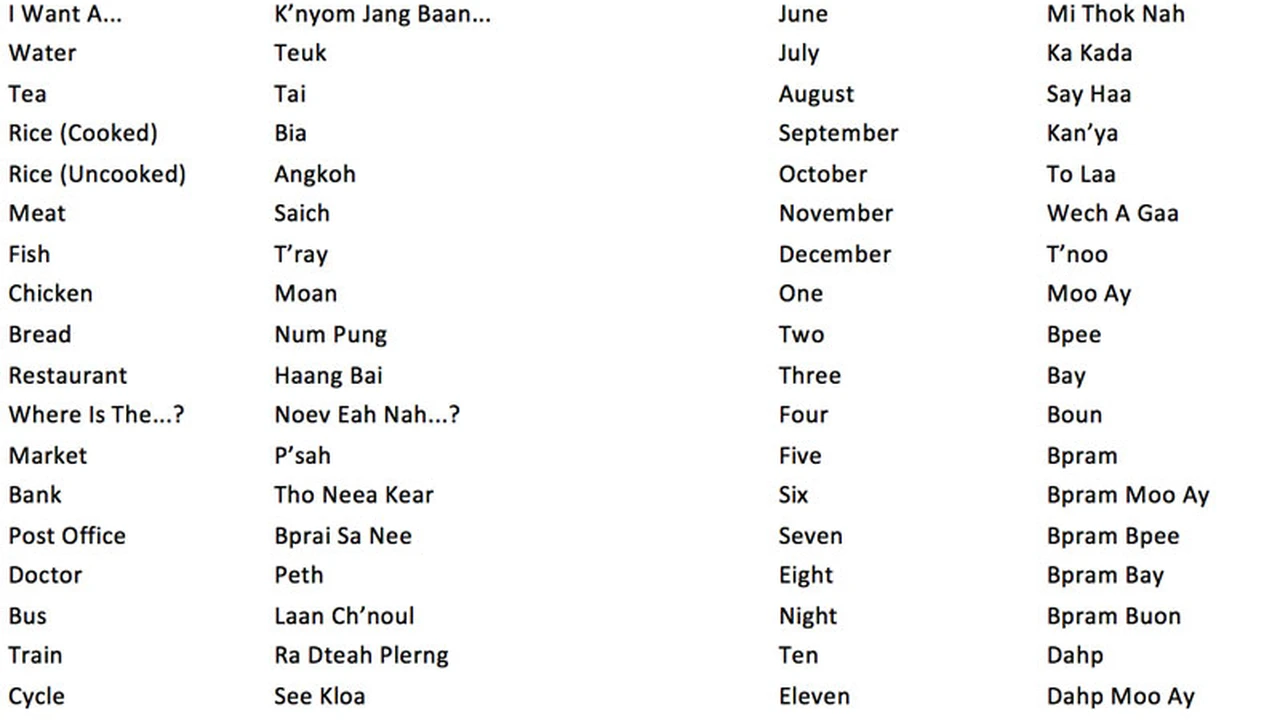Learning Khmer in Rural Cambodia: A US Traveler's Language Immersion

Why Learn Khmer? Unveiling the Magic of Rural Cambodia Through Language
So, you're thinking about venturing beyond the iconic temples of Angkor and diving into the heart of rural Cambodia? Fantastic! But let me tell you, experiencing the real Cambodia, the warmth of its people, and the richness of its culture, becomes infinitely more rewarding when you can actually speak to them. Learning Khmer isn't just about ordering noodles (though that's definitely a perk!). It's about unlocking a deeper connection, building genuine relationships, and gaining insights that no guidebook can offer.
Imagine this: You're cycling through rice paddies, the sun warming your skin, and you stop to chat with a farmer tending his water buffalo. You ask him, in Khmer, about his day, his family, his hopes for the future. Suddenly, you're not just a tourist; you're a human being connecting with another human being. That's the power of language.
My Khmer Language Immersion: A Whirlwind Adventure
I'll be honest, my Khmer wasn't exactly fluent before I embarked on my rural Cambodian adventure. I knew a few basic phrases – "Soksabay?" (How are you?) and "Orkun" (Thank you) – but that was about it. I decided to take the plunge and immerse myself in the language, figuring the best way to learn was to just jump in headfirst.
I spent several weeks living with a family in a small village, surrounded by Khmer speakers all day, every day. There were no English speakers to fall back on (well, almost none!). It was daunting at first, but incredibly rewarding. My days were filled with learning new words, practicing pronunciation, and making plenty of mistakes (which were often met with laughter and gentle corrections!).
Khmer Language Learning Resources: Apps, Books, and More for Your Cambodian Adventure
Before you even set foot in Cambodia, you can start learning Khmer! There are tons of resources available online and in print. Here are a few of my favorites:
- Language Learning Apps: Duolingo (while limited in Khmer, it's a great starting point for basic vocabulary), Memrise (offers user-created Khmer courses), and Drops (focuses on visual learning).
- Phrasebooks: Lonely Planet Khmer Phrasebook & Dictionary is a classic. It's small, portable, and packed with useful phrases.
- Online Courses: italki (connect with native Khmer tutors online), Coursera (check for introductory Khmer courses).
- Local Language Schools: Once in Cambodia, consider enrolling in a local language school for a more structured learning experience. Many offer intensive courses for travelers.
Essential Khmer Phrases for Rural Travel: Speak Like a Local (Almost!)
Okay, let's get down to the nitty-gritty. Here are some essential Khmer phrases that will come in handy during your rural Cambodian adventure:
- Greetings: "Soksabay?" (How are you?), "Soksabay te?" (Are you well?), "Chom reap suor" (Formal greeting)
- Basic Phrases: "Orkun" (Thank you), "Som toh" (Excuse me/Sorry), "Ot te" (No), "Bat" (Yes - for males), "Chaa" (Yes - for females)
- Food & Drink: "Nyam bai hao eu?" (Have you eaten yet?), "Som ot bai" (I want rice), "Som tuk teuk" (I want water), "Tlai ponman?" (How much is it?)
- Directions: "Nov ey naa?" (Where is...?), "Tang muoy..." (Go straight ahead...), "Sdom" (Right), "Chveng" (Left)
- Numbers: Learn to count from one to ten! It's incredibly useful when bargaining in markets.
Navigating the Khmer Language: Pronunciation Challenges and Tips
Khmer pronunciation can be tricky for English speakers. The language has several vowels and consonants that don't exist in English, and the tones can be subtle but important. Don't be afraid to make mistakes! Locals are usually very patient and appreciative of the effort you're making.
Here are a few tips to help you improve your Khmer pronunciation:
- Listen Carefully: Pay close attention to how native speakers pronounce words.
- Practice Regularly: Even a few minutes of practice each day can make a big difference.
- Use Online Resources: Many websites and apps offer audio recordings of Khmer words and phrases.
- Don't Be Afraid to Ask: If you're unsure about the pronunciation of a word, ask a local to repeat it for you.
Beyond Words: Non-Verbal Communication in Rural Cambodia
Communication isn't just about words. In rural Cambodia, non-verbal cues are just as important. Here are a few things to keep in mind:
- Smiling: A smile goes a long way! It's a sign of friendliness and respect.
- Eye Contact: Moderate eye contact is generally considered polite.
- Pointing: Avoid pointing with your finger. Instead, use your whole hand.
- Head Nods: A slight nod of the head can indicate agreement or understanding.
- Dress Code: Dress modestly, especially when visiting temples or other religious sites.
Khmer Language and Cultural Sensitivity: Dos and Don'ts for Respectful Interactions
Learning a few basic Khmer phrases is a great way to show respect for the local culture. Here are a few other things to keep in mind:
- Respect Elders: Show respect for elders by using formal greetings and addressing them with titles like "Lok" (Mr.) or "Lok Srey" (Mrs.).
- Remove Your Shoes: Remove your shoes before entering someone's home or a temple.
- Avoid Touching People's Heads: The head is considered the most sacred part of the body, so avoid touching it.
- Be Mindful of Your Voice Volume: Speak in a moderate tone of voice. Raising your voice can be seen as disrespectful.
- Don't Publicly Display Affection: Public displays of affection are generally frowned upon.
Recommended Products to Enhance Your Khmer Language Learning Journey
Okay, let's talk about some gear that can make your Khmer language learning experience even better. These aren't just random products; they're things I actually used and found helpful.
Portable Audio Recorder: The Zoom H1n Handy Recorder
Use Case: This little gadget is a lifesaver for recording conversations with locals. You can use it to capture pronunciation, interviews, or even just snippets of everyday conversations. It's incredibly useful for reviewing later and picking up on nuances you might have missed the first time around.
Comparison: Compared to using your phone's recorder, the Zoom H1n offers superior audio quality and a more directional microphone, which helps to reduce background noise. While your phone is convenient, the Zoom H1n is specifically designed for clear audio recording.
Price: Around $120. Worth every penny for serious language learners.
Noise-Cancelling Headphones: Sony WH-1000XM5
Use Case: Whether you're studying on a noisy bus or trying to focus in a bustling cafe, these headphones are your best friend. They block out distractions, allowing you to immerse yourself in your Khmer lessons.
Comparison: There are cheaper noise-cancelling headphones out there, but the Sony WH-1000XM5 are widely considered the best. The noise cancellation is top-notch, and the sound quality is excellent. You can also use them for making calls and listening to music.
Price: Around $400. A splurge, but a worthwhile investment if you value peace and quiet.
Language Learning Software: Rosetta Stone (Khmer)
Use Case: While not a substitute for real-world interaction, Rosetta Stone can be a helpful tool for building vocabulary and improving pronunciation. The immersive method forces you to think in Khmer, which can be beneficial.
Comparison: Compared to free language learning apps, Rosetta Stone offers a more structured and comprehensive approach. However, it's also significantly more expensive. Consider your budget and learning style when making a decision.
Price: Varies depending on the subscription plan, but expect to pay around $150-$200 for a year.
Khmer-English Dictionary App: Pleco
Use Case: This is a must-have for any Khmer language learner. Pleco is a comprehensive dictionary app with definitions, example sentences, and audio pronunciations. You can even use it to look up characters by drawing them on the screen.
Comparison: While you can find free Khmer-English dictionaries online, Pleco offers a more user-friendly interface and a wider range of features. The paid version unlocks even more content, such as example sentences and audio recordings.
Price: Free (with in-app purchases for additional features).
Travel Journal: Moleskine Classic Notebook
Use Case: Keep a travel journal to document your language learning progress, write down new words and phrases, and reflect on your experiences. Writing things down helps to solidify your memory and allows you to track your progress over time.
Comparison: Any notebook will do, but Moleskine notebooks are known for their quality paper and durable construction. They're also small and portable, making them easy to carry around with you.
Price: Around $20.
Embrace the Journey: Enjoy Your Khmer Language Adventure!
Learning Khmer is a challenging but incredibly rewarding experience. Don't be afraid to make mistakes, embrace the culture, and have fun! The more you immerse yourself in the language and the culture, the faster you'll learn and the more you'll appreciate the beauty of rural Cambodia.
:max_bytes(150000):strip_icc()/277019-baked-pork-chops-with-cream-of-mushroom-soup-DDMFS-beauty-4x3-BG-7505-5762b731cf30447d9cbbbbbf387beafa.jpg)






